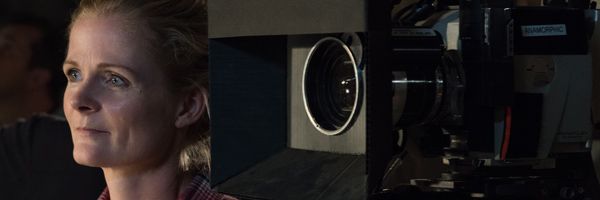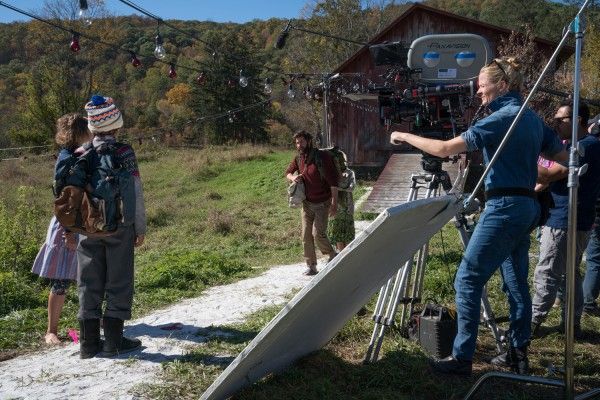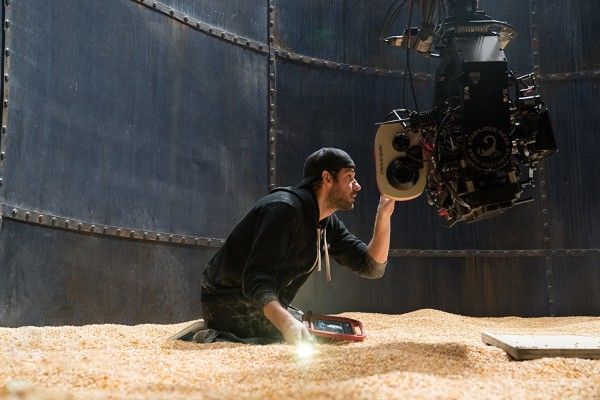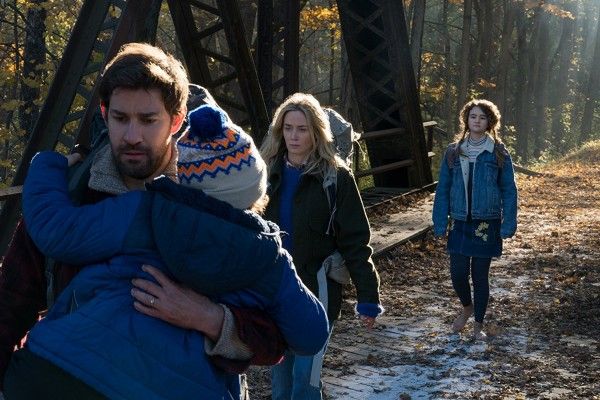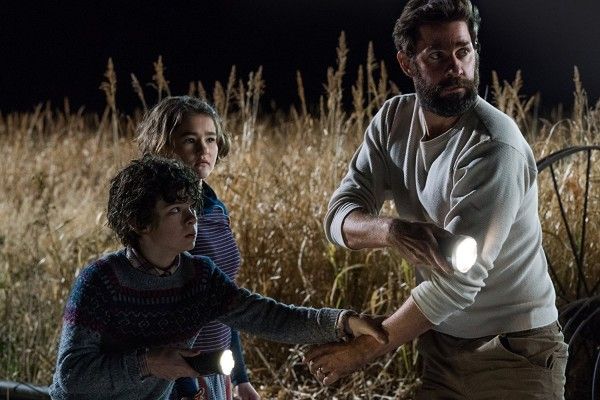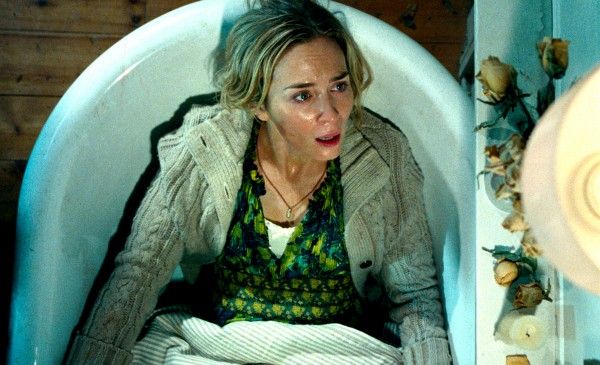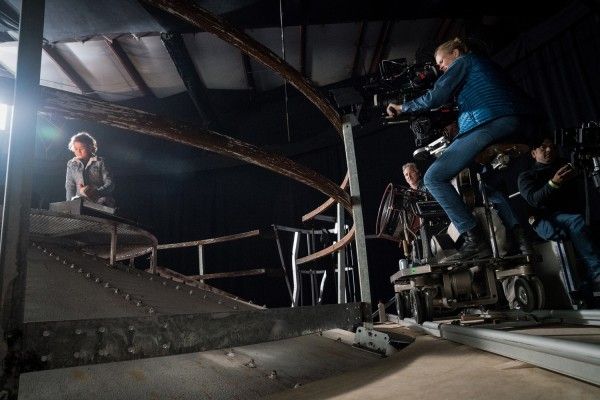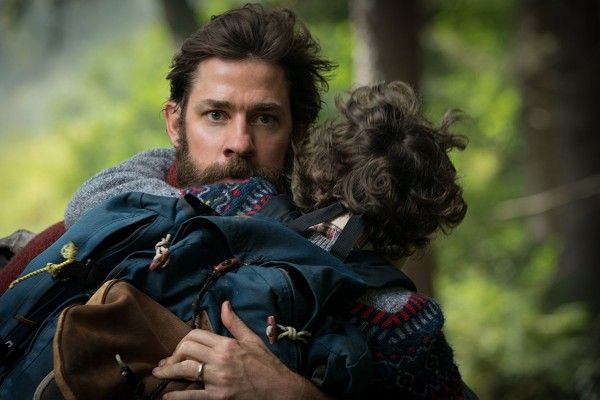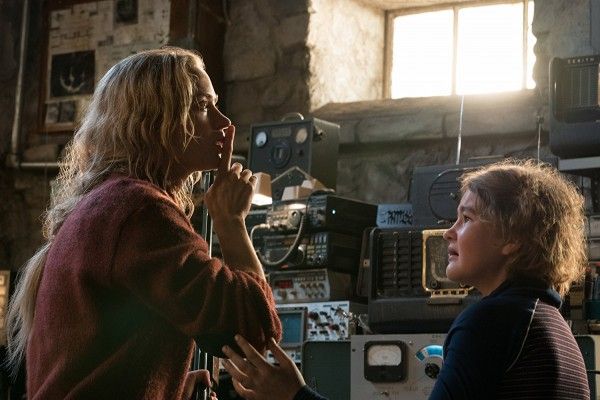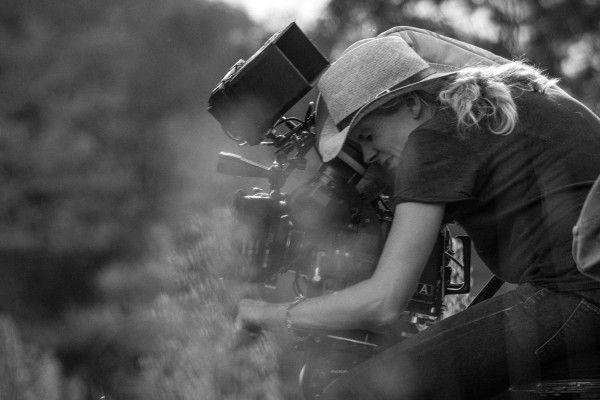The longevity of the horror genre can largely be chalked up to the diversity of stories that can be told within it. Some horror films are just straight-up delivering scares, which is perfectly fine. But others toy with larger thematic ideas, like racism (Night of the Living Dead), grief (Hereditary), or, in the case of A Quiet Place, how far a parent will go to protect his or her children.
A Quiet Place hit theaters back in April and was instantly a smash hit, going on to gross over $340 million at the worldwide box office. But the film was also a critical darling, and the fact that we’re still talking about its merits all these months later is a testament to the talent both on and off the screen. Co-writer, director, and star John Krasinski crafted a surprisingly emotional and compelling family drama packaged with some terrific scares and a winning premise. The film is bolstered by a quartet of phenomenal performances from Krasinski, Emily Blunt, Millicent Simmonds, and Noah Jupe, and it remains one of the best films of 2018.
But with a premise in which monsters will kill you if you make a sound, A Quiet Place’s success rests largely on its visuals. To bring this story to life, Krasinski turned to cinematographer Charlotte Bruus Christensen, one of the most exciting DPs working today. The Danish cinematographer’s work ranges from The Hunt to The Girl on the Train to Molly’s Game, but A Quiet Place offered new and exciting challenges. It’s no surprise that Christensen rose to the occasion, and when I was offered the chance to speak with her about her work on the film, I jumped at the opportunity.
During our interview, Christensen talked about her first discussions with Krasinski about how the film would look, the unique way in which she first became involved with the film, looking to classics like Jaws and No Country for Old Men for inspiration in confident-looking cinematography, and the challenges involved in shooting a film that takes place over the course of 24 hours with lots of location shooting. Christensen also spoke specifically about the film’s use of light and darkness and broke down how they shot a couple of the movie’s most memorable scenes, and I also asked if she’s been contacted by Krasinski about returning to shoot the in-the-works sequel.
It was a joy to be able to dig deep into the craft of this terrific film with such a talented and insightful DP, and if you’re at all interested in how A Quiet Place came together from a filmmaking perspective, I think you’ll find this a solid read. Here’s hoping Christensen’s stellar work doesn’t go unnoticed this awards season.
Check out the full interview below. A Quiet Place is currently available on Digital HD, Blu-ray, and DVD.
This is a really special film, and I know it cam together really quickly, so I was curious how you first got involved with the movie.
CHARLOTTE BRUUS CHRISTENSEN: Well, to me it didn't feel so quickly. Because Emily, who became a really close friend after we did The Girl on the Train together ... We did that in 2013, and just got really close, and our relationship kind of developed, and we're chatting every now and then. And so she called me I guess probably two years ago, like a year before we actually shot it. Some summer day, I remember, she called and she was like, "Hey, my husband John is thinking about doing this, I just think you two should work together," and can I give him your number. So we hang up and it was like 20 minutes later John calls, and he's a very energetic man. For an hour, he's like, I've got this idea, there’s this creature, I don't know yet, but it's like, I've got to rewrite it, and dah-dah-dah-dah, and do you want to do it? And I was like, sure (laughs). So, it wasn't like the regular or traditional way of going through an agent, and then you read it and then you have a Skype meeting and stuff. I just said sure, not knowing if it was ever going to happen.
And I didn't really share it with my agents until like months later because I was like, well, it's some friends calling, we don't know for sure if it’ll happen. And John started writing the script, so I was actually reading scripts every time he was doing changes. It was very fortunate, actually, that we had a year where he was writing and I was reading. And obviously, other films came up, and my agents were like, "Oh there's this film." I was like, "Oh by the way, I promised my friend Emily to do something." So it was kind of a personal friendship engagement that I obviously value very, very highly. So anyway, it came together and we had, like, a little budget. Like $17 million. So I think we were all feeling like, "Well let's go to upstate New York and bring the families." They've got kids the same age as we do, so we were like two families going up there, and this smallish crew. And I don't think we ever imagined that it was going to end up as such a hit. That was very crazy.
That's what I was going to ask you. I mean, when you're making a film like this, not only was it this kind of huge horror hit, but it's so emotional, and so affecting and so universal in its reach. You have this critical acclaim hailing it as one of the best films of the year. Did you guys have any inkling of that when you were making it, or was it just kind of like a fun little project you were doing together?
CHRISTENSEN: There were moments where you felt like it was special. And I think one couldn't really place it, in a good way. I think everybody knew that we were doing something special, and it didn’t ever feel like a small, kind of insignificant project. It felt like an important film. But we were faced, obviously, with only 30 days of shooting, and not enough money, and how can we keep the creature shots down because we don't have enough money for VFX, and having to be creative. But there were moments where everybody was like, ah ... And I felt that. I operate the camera too, so I was looking through, and I remember, there were moments where I said, “I just think I saw something very special.”
I think part of it was also that, yes, it was a project that John and Emily were doing with Paramount, but we had the freedom to dig into this idea of mixed genres, you know? The horror elements, and the scary moments and all that was one part. But there was also another part that was very important to John, and also to me, which was this is about a family. There are some very truthful and poetic cinematic moments in the whole development of the family.
I remember the very early conversations, we were talking a lot about how this project is about fear. John and I spoke about, "Well, what is it, as a family, we feel?" There is this fear, you know, with terrorism, and we've got kids, what are we going to do when in 10 years' time they want to go to a concert in Chicago? Where we have memories of terrible events, or of terrorism going on. And you go, "You can't prevent your kid from going to these places, or yourself." So this kind of fear, well what could happen? We don't know when another attack is going to be, or where. So, that was kind of a conversation about this fear being out there, and this creature kind of representing that. And how do you get through it, you know, as a family? So there were a lot of other conversations that were about the family and the pieces that people could identify with. And then you have the horror element. I think the mix of it was really interesting, and we had the freedom to develop that, because we had the time. We had a year to talk about things. So something special developed. It also felt like we had more freedom. You know, if it'd been a massive alien movie, it probably would have been set more in stone. So I think the filmmakers' voices come through in this project.
I think it's that family aspect that really makes it resonate. I re-watched it again recently, and just frames of it made me want to cry. It's such an emotional viewing experience, which I definitely was not prepared for the first time I saw it.
CHRISTENSEN: Yeah. And I think that also takes people a little bit by surprise, because it is out there as a genre movie, as a horror movie. But it's not really. And I think that's also what's refreshing about the horror aspects. That it's a thriller, but there's a very genuine, truthful, loving story about a family and about a relationship between a father and a daughter. The daughter feels guilty because she picked up those batteries to make her brother happy. But she doesn't know if the dad blames her. And he doesn't, but maybe inside, somewhere, she is responsible but obviously that's not what he wants to make her feel. So there was that whole very personal relationship going on, that was also an existing element. And her fighting and proving that she can do things even though she's deaf. So there's a lot of layers in the film. Which, some horror movies don’t have those layers. It's more about the scare. Which is also great, but this one gave us the opportunity to go deep.
Well, and given the fact that it is a world in which sound is dangerous, I mean, your job is obviously vital on any film, but this film, it’s even more important. So much of the storytelling is visual. How did you kind of hit upon what you guys wanted this film to look like, and how you were going to approach it visually?
CHRISTENSEN: I mean, John's first kind of introduction of his vision was very clear, and he always said, I think this cinematic, kind of epic feel, the poetic feel, he had those kind of overall words that were kind of covering, that gave me an idea of how to approach this. In terms of moving the camera, the moment has to be stylish, or it has to be slow. He said it’s got to be a confident movie, and I was like, oh my God, how do we do, like, a confident movie? And we looked at Jaws, and we looked at No Country for Old Men, and we looked at There Will Be Blood, which are very strong, cinematic pieces. We agreed that there is a certain confidence in those pieces, in the filmmakers' work. And we were like, "Let's be confident." So I was like, oh my God, what is that? And somehow it's simple. To me it’s like, well the camera's got to go in the right place, and you don't move if you don't need to move. You move if you're telling a story. So it became very much about simplicity. Don’t do too much. Don't try and show off. Just be in the right place. To me, that's confident. Also in life, like you’ve got to make sure that you'll feel good about what you're doing. Which is easier said than done, and to do it is obviously hard. But I think just having that at the back of my head made me offer up things and make decisions that were, you know, minimalist, somehow.
Like, the decision of red being a real color. So John would have these overall ideas. Like, you know, the red Christmas lights. And then I would start going, “Oh, we'll do red color.” And then, this movie's also about darkness. We've got to photograph black. And so, that red and the black coming together, and the candles. And then I would start kind of filling in.
I spent a long time developing this red. It's very hard to photograph red. Sometimes it looks like it's out of focus, and just little things like how we had these red Christmas lights, so the bulbs, I desperately wanted them to stay red. What happens, if you get too high a wattage, then it will just overexpose and become white. So they have to stay red, but if you do that, then they won't give any light. So how do I light the red on their faces, and what is the film light that I have to put up to get that very soft red light as if coming from a Christmas light? So, to create a minimalistic look was very, very challenging and interesting.
And then at the other side, we had a cornfield to light at night, and a view from a silo. Then, again, how do you create the night look, looking for miles and miles and miles, and seeing the Christmas lights at the barn from up there? So, on the other hand there were some bigger set-ups that I had to figure out how to achieve. It was very complicated.
In that vein, I mean, there are a number of sequences that I think are really unforgettable, but one it particular is when Emily's in the basement where the water's flooding in, and the baby's in the box. You have darkness, you have water, you have the red light, you have the creature. Can you talk a little about shooting that scene and putting it together?
CHRISTENSEN: Yeah, that was definitely also a challenge. So, we didn't have a studio. We built that set in like an indoor riding arena that was around the corner from the farm. So it was like a water tank, so we could have the water in. So we were working in that water all the time, and so we were also craned, to try and be safe with the camera. But the planning of it was crucial, because we knew we needed to photograph a dark space. And when they get down there, the first time he carries her down it’s black. Not like a film light. And they just walk through, like, a little sliver of white light, to say that they're in the room, but then other than that, it's just darkness. And when she wakes up, he's lit some candles in there.
So there was a very fine development of—and we discussed that carefully—the lights at each moment. Because then she falls asleep, when she wakes up, the water is there. And it's blown out some of the candles, and we're left with this red light from the Christmas chain, kind of lying down the stairs. So, I had to figure a way of exposing for that red light, and have light on her face, and then obviously also seeing the water. And what worked really well was to reflect the red light in the water. So you had that movement, and that light also shining back up on her face. So you had this moving red light while she’s moving towards the crib to try and get the baby. So that worked out really well.
And what I figured out was that for your eye to be able to focus on red, I needed to have a little bit of white light. Or, you know, a warm light, to focus on. So we left a couple of candle lights, which gave me a reference to just edge her a little bit with a candle light or something, so that it's not only black and red. But you had that little bit of contrast. And it just made you see the red even better. But it was a difficult working environment, of course, with the water, and there were small lights that had to be in the perfect place all the time. But it turned out really, really well.
It turned out fantastic. One of the shots that's now become iconic is the bathroom birth scene, with Emily in the tub. And I was curious, when you're shooting something like that, do you know it's going to be special? Because you literally created a piece of cinematic iconography with that sequence.
CHRISTENSEN: Thank you very much, those are very kind words. Yeah. There were several times doing this movie where I look through the—I'm operating the camera myself, so I look through the viewfinder, and there are moments in this film where I would feel like, I think I just saw something special. And I'm the first one to see it, through that eyepiece. That is one of the reasons why I'm operating, and kind of staying by that, is the experience that you have when you have your eye to a closed eyepiece, rather than a monitor. I really can see, and I get those feelings, that this one worked.
But that shot was planned. We knew we wanted to be in that top shot. And we knew we needed to tell the story of the light flickering. So that light was placed specifically to see that it's going in and out, in and out, and then we move down. You know, it was all planned, and it seems like, sure this is a good idea, and it's going to work. But Emily’s performance once she got in that bathtub [was amazing], and she did that three times, I think. You just saw how she was keeping it back, keeping it back, keeping back, and then that scream as the fireworks come. I remember we were really excited afterwards, and Emily stood up from the bathtub and she was like, “Was that all right?” (laughs). So I remember we were all really excited. I think everybody kind of felt that was special. But she just, can I just say, she's a superstar.
Oh, she's so good.
CHRISTENSEN: She just is.
They're both so good.
CHRISTENSEN: Yes.
They're both incredible. But all of them, all four of them. The kids are great too.
CHRISTENSEN: Yeah. Yeah.
I think that's kind of the secret weapon of this film, is that there's not a single weak link in this entire ensemble, and everyone came to play, and everyone just delivered.
CHRISTENSEN: Delivered, yeah. Yeah.
I was really impressed by the shot composition of the film as well. I mean, one of the shots that really breaks my heart is in the basement after they've had the child, and Emily's talking about the child they lost. And you see, you know, John's head is in the front of the frame, and it's lowered and everything. And I was wondering if you could talk a little bit about just kind of the shot composition throughout. Did John storyboard, did you guys work off of those? Was it a lot of finding the scenes in the moment?
CHRISTENSEN: We did not storyboard. We tried, because the producers were like, you've got to storyboard some scenes. The scenes with the creature and the silo scenes. And so we tried it, and it did not work for John. He has those great overall ideas, and you know, he's very strong on a concept and what he said about the concepts and those ideas really made sense to me. But once you start trying to draw it out, it just became—he was like, “I don't know what that is. I know when I see it, but it's not necessarily this.” And so, we actually didn't use storyboards. We did those but we never used them.
And the rest of the movie, we would talk about some set-ups, and John would have some scenes. He’d go like, “There was one shot in this one that's very specific.” One in particular was when he gets on the tractor in the middle of the cornfield, he gets up and he sees the creature's running towards him and passes him towards the silo. He always wanted that to be like a 180 move around on a crane. So, you know, he would have specific shots, and then I would kind of fit in the shots around it. In other scenes, he was just very trusting it would be a couple things that we spoke about loosely, but other than that, I would set up the camera and we would look at it, I would offer up something, and he would say, like, “Oh maybe it goes a little bit this way,” most of the time it worked for him.
So it was kind of created in the moment. The camera positions were found after rehearsals. I watch the rehearsals, and I walk around with my viewfinder, and I remember what we spoke about, and the notes that he's had, and I would say, “I see that right here,” and he would look through, and he'd say, “Well set it up and show it to me.” So placing the camera was like a spontaneous reaction to performances. You know, this thing I said to you earlier in the conversation, this thing of trying to find confidence. It was so much about the simplicity, even if it's a close-up. That that camera ends up in the right place. It's not just, “Oh let's make a close-up, let's move in and just make a close-up.” It's like, “Well this close-up is from this angle, because when she turns or she hears the creature or stares, she's going to turn towards camera,” or whatever it is. Every placement of the camera, we tried to do what feels confident, what feels right. And lets not do four versions. This is it. And so, I had the freedom and the trust to offer up a lot of that.
Well, it's funny you say they wanted you to do the storyboards because of the creatures, because as we now know, John changed the design of the creatures in post-production. Were you involved in post, to kind of alter the lighting or the frames as needed, or anything? Or was that something you kind of saw when the film was finished?
CHRISTENSEN: Not really. One of the big changes was that the creature ended up being a little shorter than what we originally planned, which was one of my concerns because we made the eyeline so high. And so, you know, those kind of things, we looked at. But other than that, it changed, but it didn't alter anything in terms of what we did and the placement and the movement of the creature. So my movements of the camera and the framings were still going to work. I mean, I was obviously involved in doing the whole coloring of the movie, and they screened it for me. So, you know, we still keep the conversation, but the actual changing of the creature, I think the element of that was with John and the VFX company.
One of the challenges with this film, I would think, is that it largely takes place over the course of about 24 hours or so. Is that something that's tough from your perspective, to keep the lighting consistent throughout, and then also maintaining a sense of diversity in the frame, when you're largely in one location?
CHRISTENSEN: Very much so. Yes. Yeah, we had two days. Yeah, so there's one night, and then the next day the whole thing happens, then it goes into night again. So, yes. The weather, and also because we were shooting autumn and going towards wintertime. So, we started with the leaves being green, then they turned red, and then they fell off. We had to shoot the opening at the end, because they had to look different. So, we wanted, like, a long beard on John throughout the movie, because it's been a long time. Whereas the opening of the movie, you know, this condition happened not so long ago, so we wanted to take the facial hair off later, so we shot the end first.
There were a lot of conversations. There were no leaves, or red leaves. And we were in, like, summer when we started. Like most movies, you make a plan and little bits would change. This would change daily. We would turn up and then I would have blacked out the barn, because we had to do day for night in there, and they'd go like, “Oh my God, no, it's going to be raining tomorrow, so we've got to shoot exterior barn,” so we're going to see the barn. Oh my God, now we've got to take all the black off that we did overnight with a rigging crew. And so there was a constant changing of schedule, because of weather, and because of rain coming in, and it being upstate New York autumn. So that was a huge thing for me, obviously, and also, feeling very responsible as the DP of the movie, to get the continuity. 40 percent of the days were gray, so to try and not have too many changes that the audience would feel was difficult. And then also just going into night, we have a lot of exterior shots, and very little studio work. So, it was a challenge, for sure.
Well, I think you guys pulled it off wonderfully. This film is also so different from John's other two films. From your perspective, what it was like working with him as a director? Because I think he nailed it, and I think there's a confidence in there that's really great. But on paper, this is a really ambitious film to direct for him.
CHRISTENSEN: Yeah. It was a good experience. I remember that conversation when, after Emily called and said, can my husband call you? I met him a couple of times, but it was my first kind of real conversation with him. He was so passionate about this project and his idea. I hadn't read anything at that point. That was just him telling me about some creature. And at that point, it was like they got trapped in some windmill or something. He spoke so fast, and his idea was all over the place, and I didn't really get it. I was like, sure, that sounds interesting. Creatures and a windmill. But what I do remember was just he knew that this was going to be a strong concept. I think what was special was that he knew this was going to be something special. He knew that from the very beginning. So I think that's a very strong talent, to see that. And it is very different; I know he directed other movies that are very, very different. So I think he felt strongly about it. He has a high energy level that you've got to go like, “Oh my God, I gotta eat something very healthy just to catch up with him.” But also, I think partly this thing of trying to make a confident looking movie, he did trust me to place the camera and to try and fulfill his vision. So, he was strong in terms of knowing the overall look of the movie and his intentions as a director. So I think the reason why it's a strong project is that he felt strongly about this from the very beginning. He never doubted it.
I know that he's writing the script for the sequel now. Has he already talked to you about coming back to shoot that one?
CHRISTENSEN: No.
Well, I hope he does.
CHRISTENSEN: He hasn't asked yet, but there's also, me personally, there’s also a thing of, you go and do something like that, I always said to them, “Don't make a sequel!” (laughs)It's going to be so hard.
It's scary, yeah.
CHRISTENSEN: So, I think at the moment, that's his project, and I don't know who he's going to approach about it. But also, I just feel so lucky to be part of this film that is such a success. I would really be scared to jump on a second one. But we'll see what happens, yeah.

